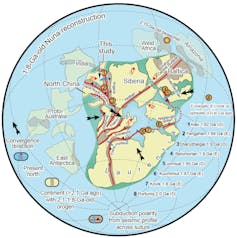Marie Tharp pioneered mapping the bottom of the ocean 6 decades ago – scientists are still learning about Earth’s last frontier
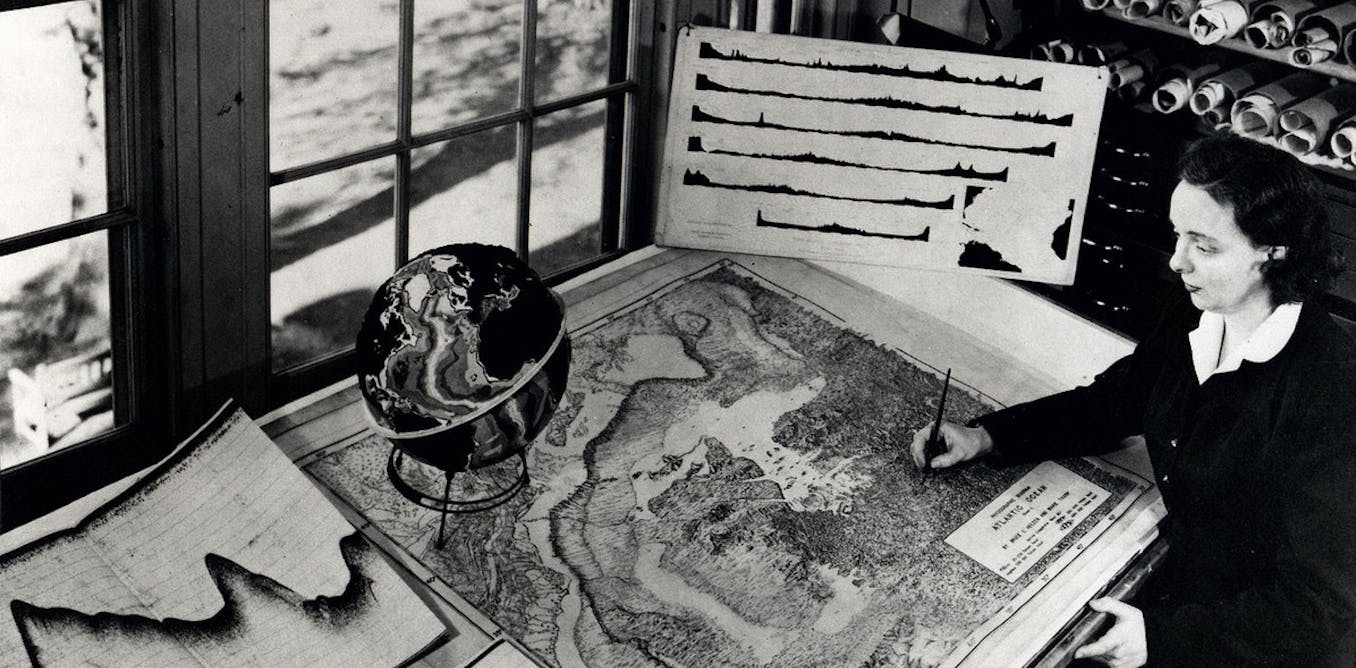
Tharp with an undersea map at her desk. Rolled sonar profiles of the ocean floor are on the shelf behind her. Lamont-Doherty Earth Observatory and the estate of Marie Tharp
Despite all the deep-sea expeditions and samples taken from the seabed over the past 100 years, humans still know very little about the ocean’s deepest reaches. And there are good reasons to learn more.
Most tsunamis start with earthquakes under or near the ocean floor. The seafloor provides habitat for fish, corals and complex communities of microbes, crustaceans and other organisms. Its topography controls currents that distribute heat, helping to regulate Earth’s climate.
Despite all the deep-sea expeditions and samples taken from the seabed over the past 100 years, humans still know very little about the ocean’s deepest reaches. And there are good reasons to learn more.
Most tsunamis start with earthquakes under or near the ocean floor. The seafloor provides habitat for fish, corals and complex communities of microbes, crustaceans and other organisms. Its topography controls currents that distribute heat, helping to regulate Earth’s climate.
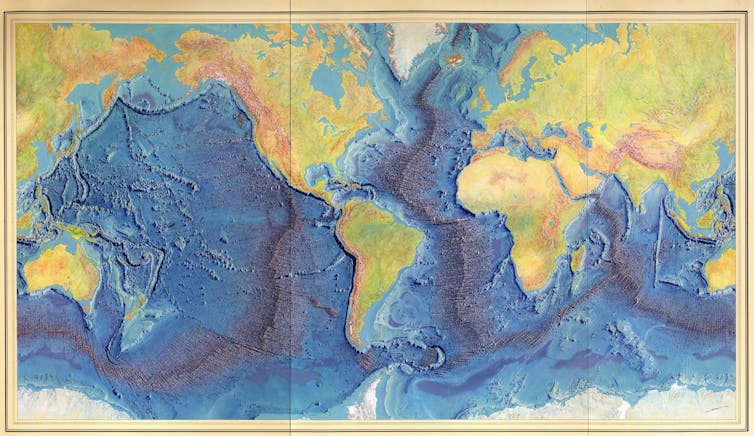
Hand-painted rendition of Heezen-Tharp 1977 ‘World ocean floor’ map, by Heinrich Berann. Library of Congress, Geography and Map Division, CC BY-ND
July 30 marks the 100th anniversary of the birth of Marie Tharp, a geologist and oceanographer who created maps that changed the way people imagine two-thirds of the world. Beginning in 1957, Tharp and her research partner, Bruce Heezen, began publishing the first comprehensive maps that showed the main features of the ocean bottom – mountains, valleys and trenches.
As a geoscientist, I believe Tharp should be as famous as Jane Goodall or Neil Armstrong. Here’s why.
Traversing the Atlantic
Well into the 1950s, many scientists assumed the seabed was featureless. Tharp showed that it contained rugged terrain, and that much of it was laid out in a systematic way.
Her images were critical to the development of plate tectonic theory – the idea that plates, or large sections of Earth’s crust, interact to generate the planet’s seismic and volcanic activity. Earlier researchers – particularly Alfred Wegener – noticed how well the coastlines of Africa and South America fit together and proposed the continents had once been connected; Tharp identified mountains and a rift valley in the center of the Atlantic Ocean where the two continents could have been ripped apart.
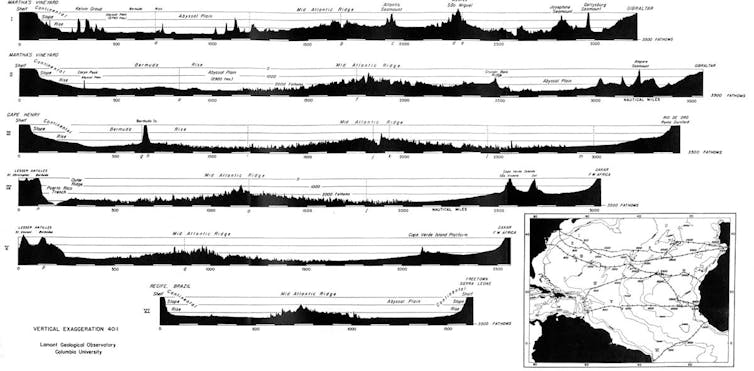
Tharp’s East-West profiles across the North Atlantic. The Floors of the Ocean, 1959
Thanks to Tharp’s hand-drawn renditions of the ocean floor, I can imagine a walk across the Atlantic Ocean bottom from New York City to Lisbon. The journey would take me out along the continental shelf. Then downward towards the Sohm Abyssal Plain. I’d need to detour around underwater mountains, called seamounts. Then I’d start a slow climb up the Mid-Atlantic Ridge, a submerged north-south mountain range.
After ascending to 8,200 feet (2,500 meters) below sea level to the ridge’s peak, I would descend several hundred feet, cross the ridge’s central rift valley and proceed up over the ridge’s eastern edge. Then back down to the ocean floor, until I began trekking up the European continental slope to Lisbon. The total walk would be about 3,800 miles (6,000 kilometers) – almost twice the length of the Appalachian Trail.
Mapping the unseen
Born in Ypsilanti, Michigan, Tharp studied English and music in college. But then in 1943 she enrolled in a University of Michigan master’s degree program designed to train women to be petroleum geologists during World War II. “Girls were needed to fill the jobs left open because the guys were off fighting,” Tharp later recalled.
After working for an oil company in Oklahoma, Tharp sought a geology job at Columbia University in 1948. Women couldn’t go on research ships, but Tharp could draft, and was hired to assist male graduate students.
Tharp worked with Bruce Heezen, a grad student who gave her seafloor profiles to draft. These are long paper rolls that show the depth of the seafloor along a linear path, measured from a ship using sonar.
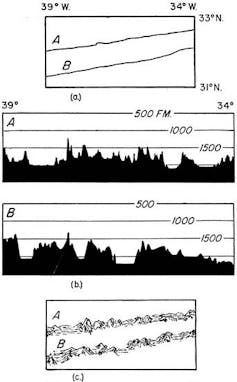 An illustration of Marie Tharp’s mapping process. (a) shows the position of two ship tracks (A, B) moving across the surface. (b) plots depth recordings as profiles, exaggerating their height to make features easier to visualize. (c) sketches features shown on the profiles. The Floors of the Ocean, 1959, Fig. 1
An illustration of Marie Tharp’s mapping process. (a) shows the position of two ship tracks (A, B) moving across the surface. (b) plots depth recordings as profiles, exaggerating their height to make features easier to visualize. (c) sketches features shown on the profiles. The Floors of the Ocean, 1959, Fig. 1Starting with a large blank sheet of paper, Tharp marked lines of latitude and longitude. Then she’d carefully mark where the ship had traveled. Next she’d read the depth at each location off the sonar profile, mark it on the ship’s track and create her own condensed profile, showing the depth to the ocean floor versus the distance the ship had traveled.
One of her important innovations was creating sketches depicting what the seafloor would look like. These views made it easier to visualize the ocean floor’s topography and create a physiographic map.
Tharp’s careful plotting of six east-to-west profiles across the North Atlantic revealed something no one had ever described before: a cleft in the center of the ocean, miles wide and hundreds of feet deep. Tharp suggested that it was a rift valley – a type of long trough that was known to exist on land.
Heezen called this idea “girl talk” and told Tharp to recalculate and redraft. When she did, the rift valley was still there.
Another research assistant was plotting locations of earthquake epicenters on a map of the same size and scale. Comparing the two maps, Heezen and Tharp realized that the earthquake epicenters fell inside the rift valley. This discovery was critical to the development of plate tectonic theory: It suggested that movement was occurring in the rift valley, and that the continents might actually be drifting apart.
This insight was revolutionary. When Heezen, as a newly-minted Ph.D., gave a talk at Princeton in 1957 and showed the rift valley and epicenters, geology department chair Harry Hess replied, “You have shaken the foundations of geology.”
Exploring mid-ocean ridges provides vast amounts of information about life on Earth.
Tectonic resistance
In 1959 the Geological Society of America published “The Floors of the Oceans: I. The North Atlantic” by Heezen, Tharp and “Doc” Ewing, director of the Lamont Observatory, where they worked. It contained Tharp’s ocean profiles, ideas and access to Tharp’s physiographic maps.
Some scientists thought the work was brilliant, but most didn’t believe it. French undersea explorer Jacques Cousteau was determined to prove Tharp wrong. Sailing aboard his research vessel, the Calypso, he purposely crossed the mid-Atlantic Ridge and lowered an underwater movie camera. To Cousteau’s surprise, the film showed that a rift valley existed.
“There’s truth to the old cliché that a picture is worth a thousand words and that seeing is believing,” Tharp observed in a 1999 retrospective essay.
What could have created the rift? Princeton’s Hess proposed some ideas in a 1962 paper. It postulated that hot magma rose from inside the Earth at the rift, expanded as it cooled and pushed two adjoining plates further apart. This idea was a key contribution to plate tectonic theory, but Hess failed to reference the critical work presented in “The Floors of the Oceans” – one of the few publications that included Tharp as a co-author.
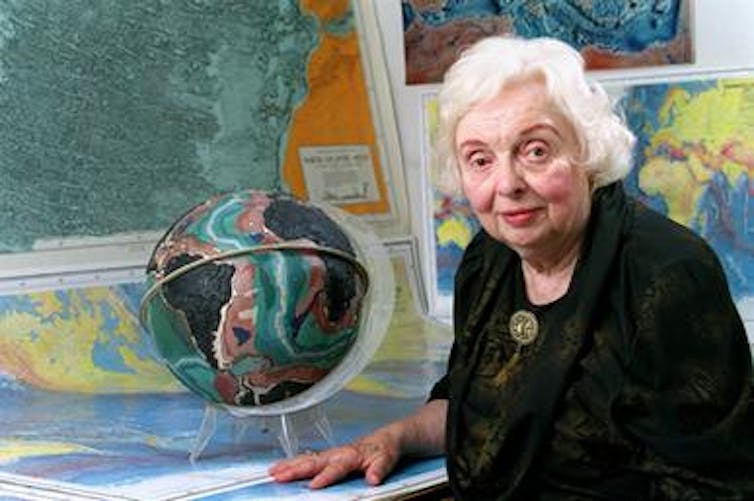
Marie Tharp in July 2001. Bruce Gilbert, Lamont-Doherty Earth Observatory
Still surveying
Tharp continued working with Heezen to bring the ocean floor to life. Their collaboration included an Indian Ocean map, published by National Geographic in 1967, and a 1977 World Ocean Floor map that is now held at the Library of Congress.
After Heezen died in 1977, Tharp continued her work until her death in 2006. In October 1978, Heezen (posthumously) and Tharp were awarded the Hubbard Medal, the National Geographic Society’s highest honor, joining the ranks of explorers and discoverers such as Ernest Shackleton, Louis and Mary Leakey and Jane Goodall.
Today ships use a method called swath mapping, which measures depth over a ribbon-like path rather than along a single line. The ribbons can be stitched together to create an accurate seafloor map.
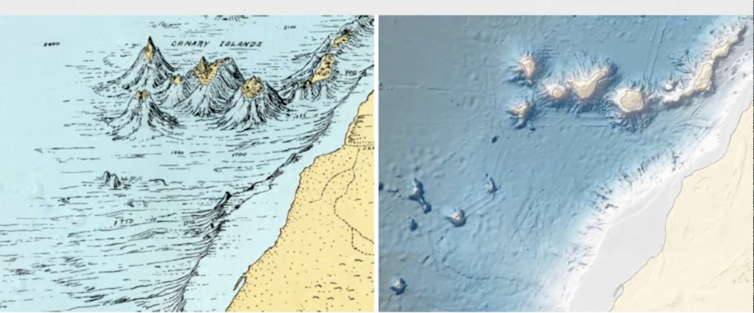
Left. Detail of Canary Islands from Marie Tharp’s physiographic map of the North Atlantic. Right. Modern swath mapping depiction of the same area. Colors indicate depth. Vicki Ferrini, Lamont-Doherty Earth Observatory.
But because ships move slowly, it would take one ship 200 years to completely map the seafloor. An international effort to map the entire ocean floor in detail by 2030 is under way, using multiple ships, led by the Nippon Foundation and the General Bathymetric Chart of the Oceans.
This information is critical to beginning to understand what the seafloor looks like on a neighborhood scale. Marie Tharp was the first person to show the rich topography of the ocean floor and its different neighborhoods.
Suzanne OConnell
Suzanne OConnell is a Friend of The Conversation.
Professor of Earth & Environmental Sciences, Wesleyan University
Disclosure statement
Suzanne OConnell does not work for, consult, own shares in or receive funding from any company or organisation that would benefit from this article, and has disclosed no relevant affiliations beyond their academic appointment.
Scientists have been drilling into the ocean floor for 50 years – here’s what they’ve found so far
September 26, 2018
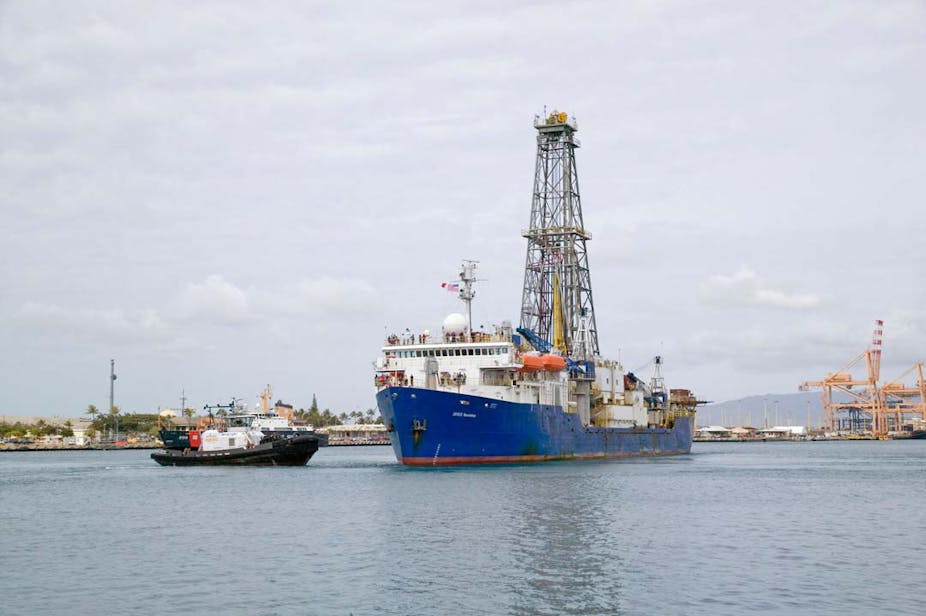
The scientific drilling ship JOIDES Resolution arrives in Honolulu after successful sea trials and testing of scientific and drilling equipment. IODP, CC BY-ND
It’s stunning but true that we know more about the surface of the moon than about the Earth’s ocean floor. Much of what we do know has come from scientific ocean drilling – the systematic collection of core samples from the deep seabed. This revolutionary process began 50 years ago, when the drilling vessel Glomar Challenger sailed into the Gulf of Mexico on August 11, 1968 on the first expedition of the federally funded Deep Sea Drilling Project.
I went on my first scientific ocean drilling expedition in 1980, and since then have participated in six more expeditions to locations including the far North Atlantic and Antarctica’s Weddell Sea. In my lab, my students and I work with core samples from these expeditions. Each of these cores, which are cylinders 31 feet long and 3 inches wide, is like a book whose information is waiting to be translated into words. Holding a newly opened core, filled with rocks and sediment from the Earth’s ocean floor, is like opening a rare treasure chest that records the passage of time in Earth’s history.
Over a half-century, scientific ocean drilling has proved the theory of plate tectonics, created the field of paleoceanography and redefined how we view life on Earth by revealing an enormous variety and volume of life in the deep marine biosphere. And much more remains to be learned.
Scientists have expanded human knowledge by drilling core samples from the world’s ocean basins, but their work is far from done.
Technological innovations
Two key innovations made it possible for research ships to take core samples from precise locations in the deep oceans. The first, known as dynamic positioning, enables a 471-foot ship to stay fixed in place while drilling and recovering cores, one on top of the next, often in over 12,000 feet of water.
Anchoring isn’t feasible at these depths. Instead, technicians drop a torpedo-shaped instrument called a transponder over the side. A device called a transducer, mounted on the ship’s hull, sends an acoustic signal to the transponder, which replies. Computers on board calculate the distance and angle of this communication. Thrusters on the ship’s hull maneuver the vessel to stay in exactly the same location, countering the forces of currents, wind and waves.
Another challenge arises when drill bits have to be replaced mid-operation. The ocean’s crust is composed of igneous rock that wears bits down long before the desired depth is reached.
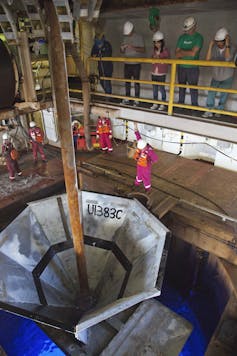 The re-entry cone is welded together around the drill pipe, then lowered down the pipe to guide reinsertion before changing drill bits. IODP, CC BY-ND
The re-entry cone is welded together around the drill pipe, then lowered down the pipe to guide reinsertion before changing drill bits. IODP, CC BY-ND
When this happens, the drill crew brings the entire drill pipe to the surface, mounts a new drill bit and returns to the same hole. This requires guiding the pipe into a funnel shaped re-entry cone, less than 15 feet wide, placed in the bottom of the ocean at the mouth of the drilling hole. The process, which was first accomplished in 1970, is like lowering a long strand of spaghetti into a quarter-inch-wide funnel at the deep end of an Olympic swimming pool.
Confirming plate tectonics
When scientific ocean drilling began in 1968, the theory of plate tectonics was a subject of active debate. One key idea was that new ocean crust was created at ridges in the seafloor, where oceanic plates moved away from each other and magma from earth’s interior welled up between them. According to this theory, crust should be new material at the crest of ocean ridges, and its age should increase with distance from the crest.
The only way to prove this was by analyzing sediment and rock cores. In the winter of 1968-1969, the Glomar Challenger drilled seven sites in the South Atlantic Ocean to the east and west of the Mid-Atlantic ridge. Both the igneous rocks of the ocean floor and overlying sediments aged in perfect agreement with the predictions, confirming that ocean crust was forming at the ridges and plate tectonics was correct.
 Part of a core section from the Chicxulub impact crater. It is suevite, a type of rock, formed during the impact, that contains rock fragments and melted rocks. IODP, CC BY-ND
Part of a core section from the Chicxulub impact crater. It is suevite, a type of rock, formed during the impact, that contains rock fragments and melted rocks. IODP, CC BY-ND
Reconstructing earth’s history
The ocean record of Earth’s history is more continuous than geologic formations on land, where erosion and redeposition by wind, water and ice can disrupt the record. In most ocean locations sediment is laid down particle by particle, microfossil by microfossil, and remains in place, eventually succumbing to pressure and turning into rock.
Microfossils (plankton) preserved in sediment are beautiful and informative, even though some are smaller than the width of a human hair. Like larger plant and animal fossils, scientists can use these delicate structures of calcium and silicon to reconstruct past environments.
Thanks to scientific ocean drilling, we know that after an asteroid strike killed all non-avian dinosaurs 66 million years ago, new life colonized the crater rim within years, and within 30,000 years a full ecosystem was thriving. A few deep ocean organisms lived right through the meteorite impact.
Ocean drilling has also shown that ten million years later, a massive discharge of carbon – probably from extensive volcanic activity and methane released from melting methane hydrates – caused an abrupt, intense warming event, or hyperthermal, called the Paleocene-Eocene Thermal Maximum. During this episode, even the Arctic reached over 73 degrees Fahrenheit.
The resulting acidification of the ocean from the release of carbon into the atmosphere and ocean caused massive dissolution and change in the deep ocean ecosystem.
This episode is an impressive example of the impact of rapid climate warming. The total amount of carbon released during the PETM is estimated to be about equal to the amount that humans will release if we burn all of Earth’s fossil fuel reserves. Yet, an important difference is that the carbon released by the volcanoes and hydrates was at a much slower rate than we are currently releasing fossil fuel. Thus we can expect even more dramatic climate and ecosystem changes unless we stop emitting carbon.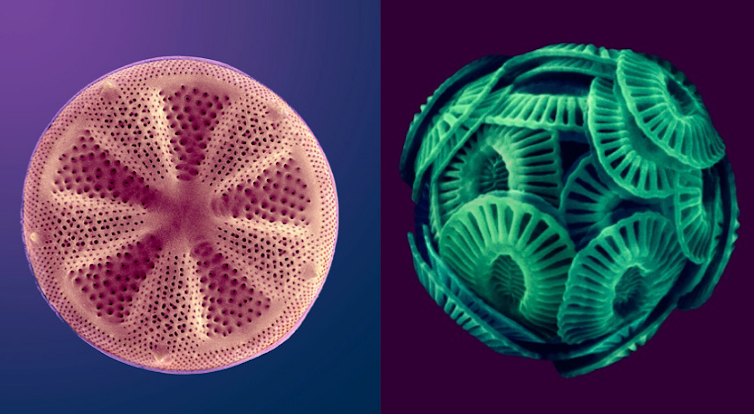 Enhanced scanning electron microscope images of phytoplankton (left, a diatom; right, a coccolithophore). Different phytoplankton species have distinct climatic preferences, which makes them ideal indicators of surface ocean conditions. Dee Breger, CC BY-NC-ND
Enhanced scanning electron microscope images of phytoplankton (left, a diatom; right, a coccolithophore). Different phytoplankton species have distinct climatic preferences, which makes them ideal indicators of surface ocean conditions. Dee Breger, CC BY-NC-ND
Finding life in ocean sediments
Scientific ocean drilling has also shown that there are roughly as many cells in marine sediment as in the ocean or in soil. Expeditions have found life in sediments at depths over 8000 feet; in seabed deposits that are 86 million years old; and at temperatures above 140 degrees Fahrenheit.
Today scientists from 23 nations are proposing and conducting research through the International Ocean Discovery Program, which uses scientific ocean drilling to recover data from seafloor sediments and rocks and to monitor environments under the ocean floor. Coring is producing new information about plate tectonics, such as the complexities of ocean crust formation, and the diversity of life in the deep oceans.
This research is expensive, and technologically and intellectually intense. But only by exploring the deep sea can we recover the treasures it holds and better understand its beauty and complexity.
Suzanne OConnell is a Friend of The Conversation.
Professor of Earth & Environmental Sciences, Wesleyan University
Disclosure statement
Suzanne OConnell does not work for, consult, own shares in or receive funding from any company or organisation that would benefit from this article, and has disclosed no relevant affiliations beyond their academic appointment.
Scientists have been drilling into the ocean floor for 50 years – here’s what they’ve found so far
September 26, 2018

The scientific drilling ship JOIDES Resolution arrives in Honolulu after successful sea trials and testing of scientific and drilling equipment. IODP, CC BY-ND
It’s stunning but true that we know more about the surface of the moon than about the Earth’s ocean floor. Much of what we do know has come from scientific ocean drilling – the systematic collection of core samples from the deep seabed. This revolutionary process began 50 years ago, when the drilling vessel Glomar Challenger sailed into the Gulf of Mexico on August 11, 1968 on the first expedition of the federally funded Deep Sea Drilling Project.
I went on my first scientific ocean drilling expedition in 1980, and since then have participated in six more expeditions to locations including the far North Atlantic and Antarctica’s Weddell Sea. In my lab, my students and I work with core samples from these expeditions. Each of these cores, which are cylinders 31 feet long and 3 inches wide, is like a book whose information is waiting to be translated into words. Holding a newly opened core, filled with rocks and sediment from the Earth’s ocean floor, is like opening a rare treasure chest that records the passage of time in Earth’s history.
Over a half-century, scientific ocean drilling has proved the theory of plate tectonics, created the field of paleoceanography and redefined how we view life on Earth by revealing an enormous variety and volume of life in the deep marine biosphere. And much more remains to be learned.
Scientists have expanded human knowledge by drilling core samples from the world’s ocean basins, but their work is far from done.
Technological innovations
Two key innovations made it possible for research ships to take core samples from precise locations in the deep oceans. The first, known as dynamic positioning, enables a 471-foot ship to stay fixed in place while drilling and recovering cores, one on top of the next, often in over 12,000 feet of water.
Anchoring isn’t feasible at these depths. Instead, technicians drop a torpedo-shaped instrument called a transponder over the side. A device called a transducer, mounted on the ship’s hull, sends an acoustic signal to the transponder, which replies. Computers on board calculate the distance and angle of this communication. Thrusters on the ship’s hull maneuver the vessel to stay in exactly the same location, countering the forces of currents, wind and waves.
Another challenge arises when drill bits have to be replaced mid-operation. The ocean’s crust is composed of igneous rock that wears bits down long before the desired depth is reached.
 The re-entry cone is welded together around the drill pipe, then lowered down the pipe to guide reinsertion before changing drill bits. IODP, CC BY-ND
The re-entry cone is welded together around the drill pipe, then lowered down the pipe to guide reinsertion before changing drill bits. IODP, CC BY-NDWhen this happens, the drill crew brings the entire drill pipe to the surface, mounts a new drill bit and returns to the same hole. This requires guiding the pipe into a funnel shaped re-entry cone, less than 15 feet wide, placed in the bottom of the ocean at the mouth of the drilling hole. The process, which was first accomplished in 1970, is like lowering a long strand of spaghetti into a quarter-inch-wide funnel at the deep end of an Olympic swimming pool.
Confirming plate tectonics
When scientific ocean drilling began in 1968, the theory of plate tectonics was a subject of active debate. One key idea was that new ocean crust was created at ridges in the seafloor, where oceanic plates moved away from each other and magma from earth’s interior welled up between them. According to this theory, crust should be new material at the crest of ocean ridges, and its age should increase with distance from the crest.
The only way to prove this was by analyzing sediment and rock cores. In the winter of 1968-1969, the Glomar Challenger drilled seven sites in the South Atlantic Ocean to the east and west of the Mid-Atlantic ridge. Both the igneous rocks of the ocean floor and overlying sediments aged in perfect agreement with the predictions, confirming that ocean crust was forming at the ridges and plate tectonics was correct.
 Part of a core section from the Chicxulub impact crater. It is suevite, a type of rock, formed during the impact, that contains rock fragments and melted rocks. IODP, CC BY-ND
Part of a core section from the Chicxulub impact crater. It is suevite, a type of rock, formed during the impact, that contains rock fragments and melted rocks. IODP, CC BY-NDReconstructing earth’s history
The ocean record of Earth’s history is more continuous than geologic formations on land, where erosion and redeposition by wind, water and ice can disrupt the record. In most ocean locations sediment is laid down particle by particle, microfossil by microfossil, and remains in place, eventually succumbing to pressure and turning into rock.
Microfossils (plankton) preserved in sediment are beautiful and informative, even though some are smaller than the width of a human hair. Like larger plant and animal fossils, scientists can use these delicate structures of calcium and silicon to reconstruct past environments.
Thanks to scientific ocean drilling, we know that after an asteroid strike killed all non-avian dinosaurs 66 million years ago, new life colonized the crater rim within years, and within 30,000 years a full ecosystem was thriving. A few deep ocean organisms lived right through the meteorite impact.
Ocean drilling has also shown that ten million years later, a massive discharge of carbon – probably from extensive volcanic activity and methane released from melting methane hydrates – caused an abrupt, intense warming event, or hyperthermal, called the Paleocene-Eocene Thermal Maximum. During this episode, even the Arctic reached over 73 degrees Fahrenheit.
The resulting acidification of the ocean from the release of carbon into the atmosphere and ocean caused massive dissolution and change in the deep ocean ecosystem.
This episode is an impressive example of the impact of rapid climate warming. The total amount of carbon released during the PETM is estimated to be about equal to the amount that humans will release if we burn all of Earth’s fossil fuel reserves. Yet, an important difference is that the carbon released by the volcanoes and hydrates was at a much slower rate than we are currently releasing fossil fuel. Thus we can expect even more dramatic climate and ecosystem changes unless we stop emitting carbon.
 Enhanced scanning electron microscope images of phytoplankton (left, a diatom; right, a coccolithophore). Different phytoplankton species have distinct climatic preferences, which makes them ideal indicators of surface ocean conditions. Dee Breger, CC BY-NC-ND
Enhanced scanning electron microscope images of phytoplankton (left, a diatom; right, a coccolithophore). Different phytoplankton species have distinct climatic preferences, which makes them ideal indicators of surface ocean conditions. Dee Breger, CC BY-NC-NDFinding life in ocean sediments
Scientific ocean drilling has also shown that there are roughly as many cells in marine sediment as in the ocean or in soil. Expeditions have found life in sediments at depths over 8000 feet; in seabed deposits that are 86 million years old; and at temperatures above 140 degrees Fahrenheit.
Today scientists from 23 nations are proposing and conducting research through the International Ocean Discovery Program, which uses scientific ocean drilling to recover data from seafloor sediments and rocks and to monitor environments under the ocean floor. Coring is producing new information about plate tectonics, such as the complexities of ocean crust formation, and the diversity of life in the deep oceans.
This research is expensive, and technologically and intellectually intense. But only by exploring the deep sea can we recover the treasures it holds and better understand its beauty and complexity.

